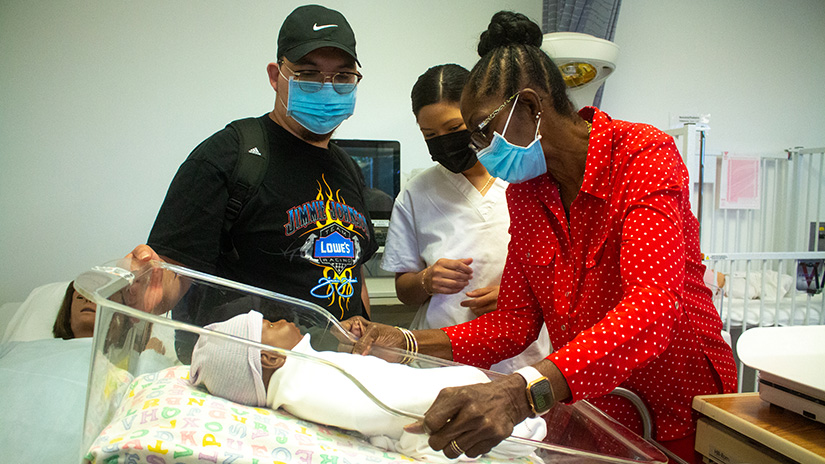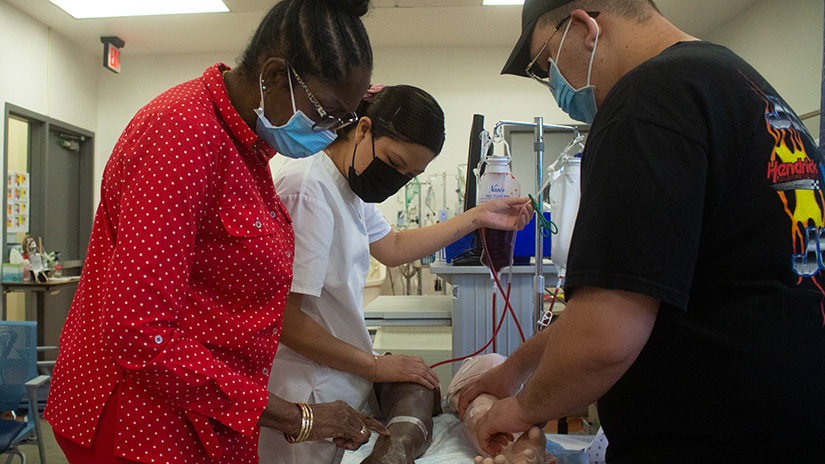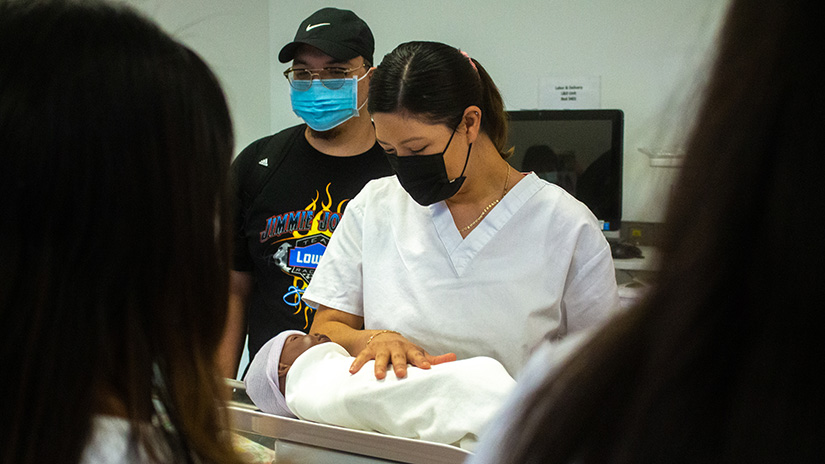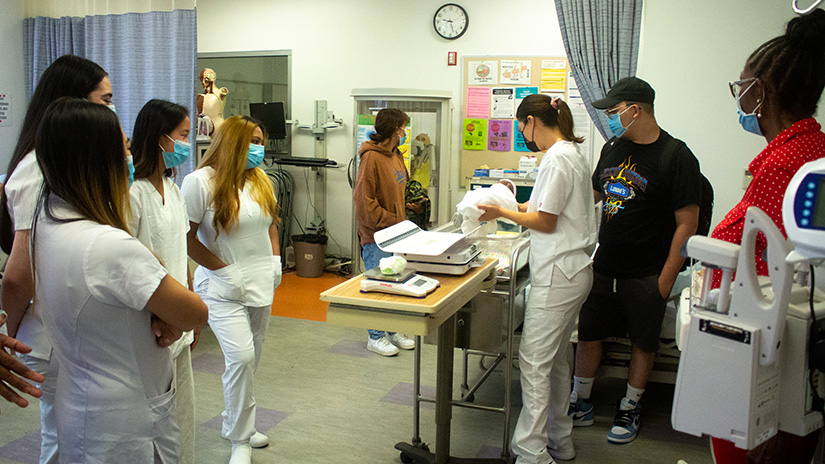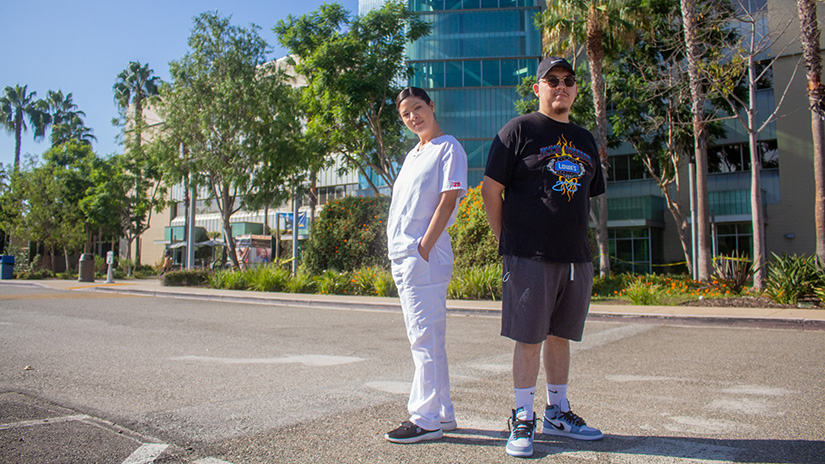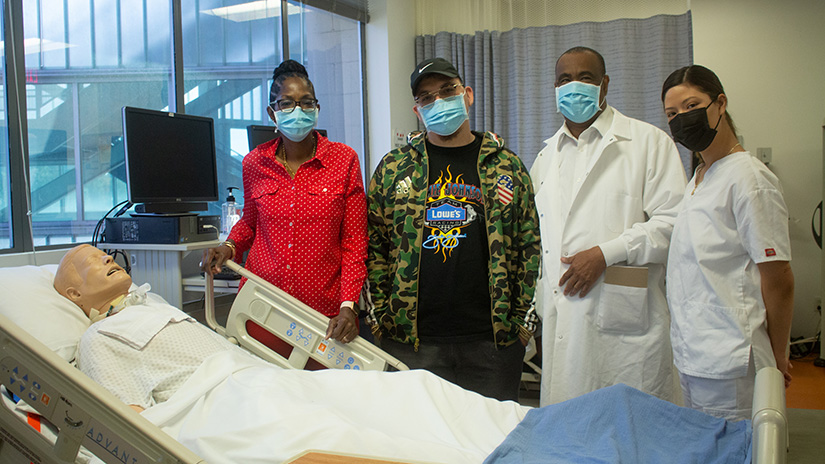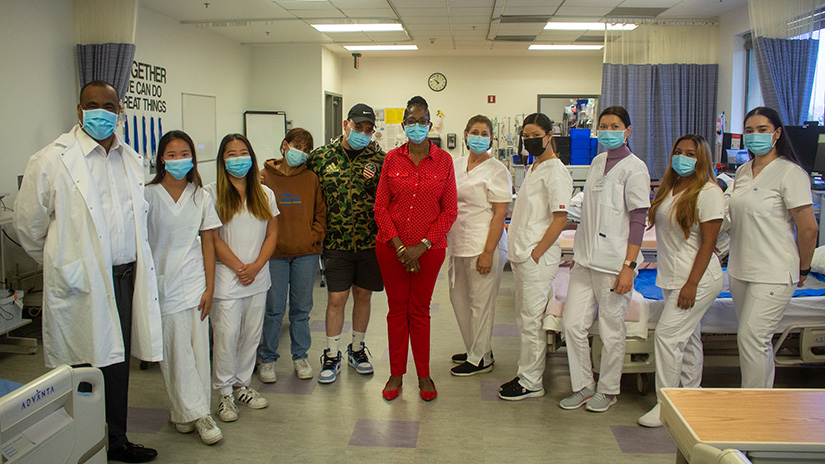
It’s Tuesday, September 13, week-three in the maiden voyage of SMC’s Certified Nursing Assistant program.
Trainees Isaura Gutierrez and Iris Carrillo are taking “patient” Henry Munguin’s vital signs. Once they’ve eased him from the hospital bed into a stable sitting position, Isaura wraps the blood pressure cuff around Henry’s arm. Iris places a digital thermometer in his mouth. Next they carefully maneuver him into the wheelchair waiting by his bedside.
“Perfect,” says Juliet Carter-Daley, as the students complete the transfer.
It’s their second day focusing on long-term care. Still to come are modules on rehabilitative nursing, observation and charting, death and dying, and patient abuse.
Henry is a CNA trainee playing the role of an elderly patient in a mock hospital ward on the Bundy Campus.
Week-four and week-five, however, will take the trainees outside the classroom into a skilled nursing facility. Under Juliet’s watchful eye, they will assist RNs caring for real residents at Marycrest Manor in Culver City.
Juliet is the CNA program’s head instructor. After more than a year of planning, the noncredit certificate program is up and running.
Juliet’s first cohort of 11 trainees are pioneers in SMC’s bold Noncredit Initiatives. (see sidebar) Five of them continued their training in the follow-on Home Health Aide certificate program, also led by Juliet and new this semester. That two-week, 54-hour program concluded its inaugural run October 14.
The push for these noncredit certificate courses is driven by urgent workforce needs.
“We have a terrible shortage of certified nursing assistants, just as we have a terrible shortage of registered nurses,” says Eric Williams, director of SMC’s Nursing Program and interim associate dean of health sciences. “Our goal is to build a pipeline.”
The CNA’s job is to support registered nurses by providing basic hygiene and patient care. According to the U.S. Bureau of Labor, there are fewer than 100,000 CNAs in California, a state with 6 million senior citizens.
This yawning workforce gap converges with rising demand for low-cost, easy-to-access learning opportunities for “post-traditional” students—people who increasingly look to community colleges for vocational training.
California already has hundreds of CNA training programs. There are 130 in Los Angeles County alone, including seven at area community colleges. But many require three months to complete, and average tuition and fees run around $1,800. The price can be far steeper at for-profit colleges.
The beauty of SMC’s new program is that it’s compressed into just five weeks. And because it’s noncredit, it can be delivered tuition-free.
“Noncredit classes have no enrollment fees,” explains Scott Silverman, dean of noncredit and external programs. In all other respects, the new program is similar to for-credit CNA certificate programs. No grades are given, but students receive progress indicators and the certificate is noted on their transcripts.
~
Enrolling in “Health 985 and 986: Certified Nursing Assistant” means committing to three weeks of intensive foundational training followed by two weeks of clinical practicums in a skilled nursing facility. The program is fully accredited, and it’s rigorous. Students completing the 180-hour curriculum are eligible to sit for the NNAAP competency exam required for state licensure.
“My students are very focused,” says Juliet, an RN with extensive prior experience teaching CNA courses. “They’re working hard, and they’re really making it a priority to get this done.”
Classes—comprised of 17 lectures and 17 lab modules—meet five days a week, eight hours a day.
“They come in at 7 a.m., and they’re ready to go,” Juliet says.
The effort pays dividends almost immediately.
“Some want to become RNs, so they’re doing this certificate as a way to get into a nursing program,” Juliet says. Others will find steady jobs in hospitals and skilled nursing facilities. CNAs in California earn on average $40,000 a year.
~
Jose Abularach, 24, and his sister Katie, 20, are learning a lot in the class. Both are current SMC students eyeing a pre-nursing major. When they heard about the CNA program through Adelante, they signed up immediately.
“It seemed like such an invaluable learning opportunity,” Jose says. “Normally this class is very expensive. I know—because we’ve been looking at other programs.”
Originally from Guatemala, the siblings live with their parents in Culver City.
For Katie, the first day cemented her decision to apply for admission to SMC’s selective nursing program. Jose is still on the fence. For now, he’s an undecided major working fulltime as a Starbucks barista.
Whatever the future holds, Jose is grateful to have this credential under his belt.
“I will always have these skills,” he says.
~
For Iris Carrillo, 21, SMC’s noncredit CNA certificate came as a godsend.
Inspired by her grandmother, a nurse back in her native Mexico, Iris dreams of a career in travel nursing. In June, she finished the two-year ADN degree at Cal State Fullerton and is currently applying to BSN programs. Her top choice is Ohio State University, but she’s also looking at schools in Mississippi and Washington.
Currently Iris works as a board certified behavior analyst for Autism Learning Partners, and she has a second job as an on-site chef for various caterers. To get a jump on GE requirements for her BSN, she’s enrolled in two online courses this fall.
Clearly, Iris has no free time, but over the summer she started looking into CNA certificate programs. In some states, though not in California, the credential is a requirement for nursing school admission. It’s also a terrific resume booster.
The cost and time-commitment, however, seemed insurmountable barriers.
“Some other CNA programs I looked at take a year or half a year,” Iris say. “I don’t have that much time. And I don’t have thousands of dollars on top of the nursing school tuition I will have to pay.”
She sees the CNA training she’s receiving at SMC as “a crucial part of my education, because it allows me to be a shadow and watch how nurses operate. To eavesdrop. To see what works for them and what works for me.”
For now, that means taking Henry for a ride around the skills lab.
Rolling the wheelchair back to the bedside, Iris and Isaura carefully hold him in a two-person hug, lift and pivot his torso, then gently arrange his legs and tip him back into a recumbent position. Using the sheet underneath, they shift him up the bed, lowering his head and arms on surrounding pillows. Draping him with the blanket, they wish him: “Goodnight.”
* * *




